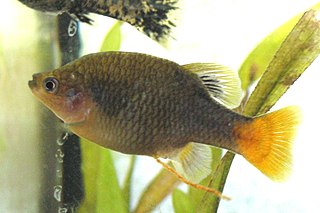
Goodeidae is a family of teleost fish endemic to Mexico and some areas of the United States. Many species are known as splitfins. This family contains about 50 species within 18 genera. The family is named after ichthyologist George Brown Goode (1851-1896).

Fundulus is a genus of ray-finned fishes in the superfamily Funduloidea, family Fundulidae. It belongs to the order of toothcarps (Cyprinodontiformes), and therein the large suborder Cyprinodontoidei. Most of its closest living relatives are egg-laying, with the notable exception of the splitfin livebearers (Goodeidae).
Paraneetroplus is a genus of cichlid fish native to moderately to fast-flowing waters in the Coatzacoalcos, Grijalva and Papaloapan river basins in southern Mexico. They reach up to 20–25.5 cm (8–10 in) in length.
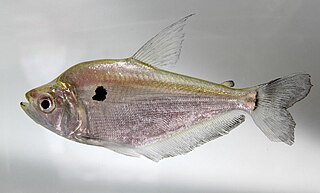
Roeboides is a genus of characins from Central and South America. These fish, among other characteristics, are small, are typically translucent, and have a rhomboid shape.

Thorichthys is a genus of cichlid fish that is native to the Atlantic slope of Middle America, ranging from southern Veracruz and the Yucatán Peninsula in Mexico, to Guatemala and Honduras, with introduced populations in a few other countries. They tend to inhabit moderately-flowing to standing water such as rivers, streams, lakes, ditches and lagoons, and they are primarily freshwater fish, although T. helleri and T. meeki may occur in slightly brackish habitats.

Vieja is a genus of cichlid fish from Central America and Mexico. The majority of the species are freshwater fish found in stagnant or slow-moving waters of southern Mexico to El Salvador, but V. maculicauda, which also occurs in brackish waters, ranges south to Panama. They are high-bodied cichlids that reach lengths of up to 17–35 cm (7–14 in) depending on the exact species. Vieja feed mostly on vegetable matter, but may also take small invertebrates.

Herichthys is a small genus of cichlid fishes. Most are endemic to Mexico, but H. cyanoguttatus is also found in southern Texas, and has been introduced to central Texas and Florida. In 2015, the genus was split, and 7 species moved into Nosferatu.

The Salvin's cichlid, also known as the yellow-belly cichlid or tricolored cichlid, is a species of the family Cichlidae. It is found in rivers of the Atlantic slope of southern Mexico, Belize, and Guatemala.

The Cichlasomatinae are a subfamily of cichlid fishes, including all cichlids native to the Greater Antilles, United States, Mexico and Central America, and many of the cichlids from South America. The subfamily Cichlasomatinae is often divided into two tribes: Cichlasomatini and Heroini, however some authorities classify these two tribes as part of the wider Neotropical and marginally Nearctic subfamily Cichlinae.

Heterandria is a genus of livebearing fishes within the family Poeciliidae. Most species occur in Guatemala and its surroundings, particularly Mexico, but the midget livebearer (H. formosa) comes from the southeastern United States.

Heroini is a fish tribe from the Cichlasomatinae subfamily in the cichlid family. All cichlids native to the Greater Antilles, United States, Mexico and northern Central America are members of this tribe. It also includes most cichlid species in southern Central America and several species from South America. A large percentage of its species were formerly placed in the genus Cichlasoma but have since been moved to other genera.
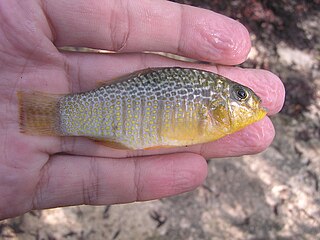
Floridichthys is a genus of pupfishes native to the southeastern United States, Mexico and northern Central America. The name of this genus is a compound of Florida and the Greek for "fish", ichthys. The ichthyologist Carl Leavitt Hubbs thought that the genus was confined to Florida at the time he coined the name.

Profundulidae is a family of killifishes. The species of this family are native to Central America and Mexico.

Anablepsoides is a genus of killifish in the family Rivulidae native to tropical South America and the Lesser Antilles. The majority are from the Amazon and Orinoco basins, as well as freshwater systems in the Guiana Shield, but a few species are from northern Venezuela, northeastern Brazil and the Lesser Antilles. Although largely restricted to lowlands, a few species occur in the lower East Andean foothills. They are mostly found in shallow fresh water swamps, streams, edges of rivers, ponds and pools, but a few may occur in brackish estuaries. They are able to jump over land and breathe air for short periods, allowing them to access isolated waters inhabited by few or no other fish. Several Anablepsoides species have small distributions and some are seriously threatened by habitat loss; the entire known range of A. xinguensis is in the area flooded by the Belo Monte Dam.
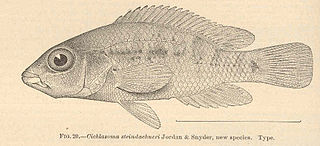
Nosferatu steindachneri, Steindachner's cichlid, is a species of cichlid endemic to Mexico where it is found in the Tamasopo, Gallinas and Ojo Frio Rivers of the Panuco River basin. It reaches a maximum size of 40.0 centimetres (15.7 in) SL. This species can also be found in the aquarium trade. The specific name honours the Austrian ichthyologist Franz Steindachner (1834-1919).
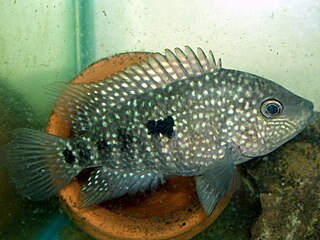
Herichthys teporatus, also known as the Soto la Marina cichlid, is a species of cichlid fish endemic to Mexico where it occurs in the Soto La Marina River drainage in the state of Tamaulipas.

Tlaloc is a genus of fish in the family Profundulidae endemic to Mexico, Guatemala and Honduras. The genus is not, however, recognised by Fishbase or in the 5th Edition of Fishes of the World. The genus is named for Tlaloc the water god of the Aztecs.
Events in the year 1981 in Mexico.

Chuco is a genus of medium-sized cichlid fishes from moderately to fast-flowing rivers and streams on the Atlantic slope of southern Mexico and northern Central America.

Astyanax caballeroi is a small species of freshwater fish endemic to a single lake system in Mexico. It has a longer snout and more slender body than most other species in the genus Astyanax, thought to be the result of predatory behavior; while A. caballeroi eats invertebrates and smaller fish, other Astyanax species are more broadly omnivorous, and have deeper bodies with shorter snouts. This difference in body shape once placed A. caballeroi, along with several other species of Astyanax, into the former genus Bramocharax.



















